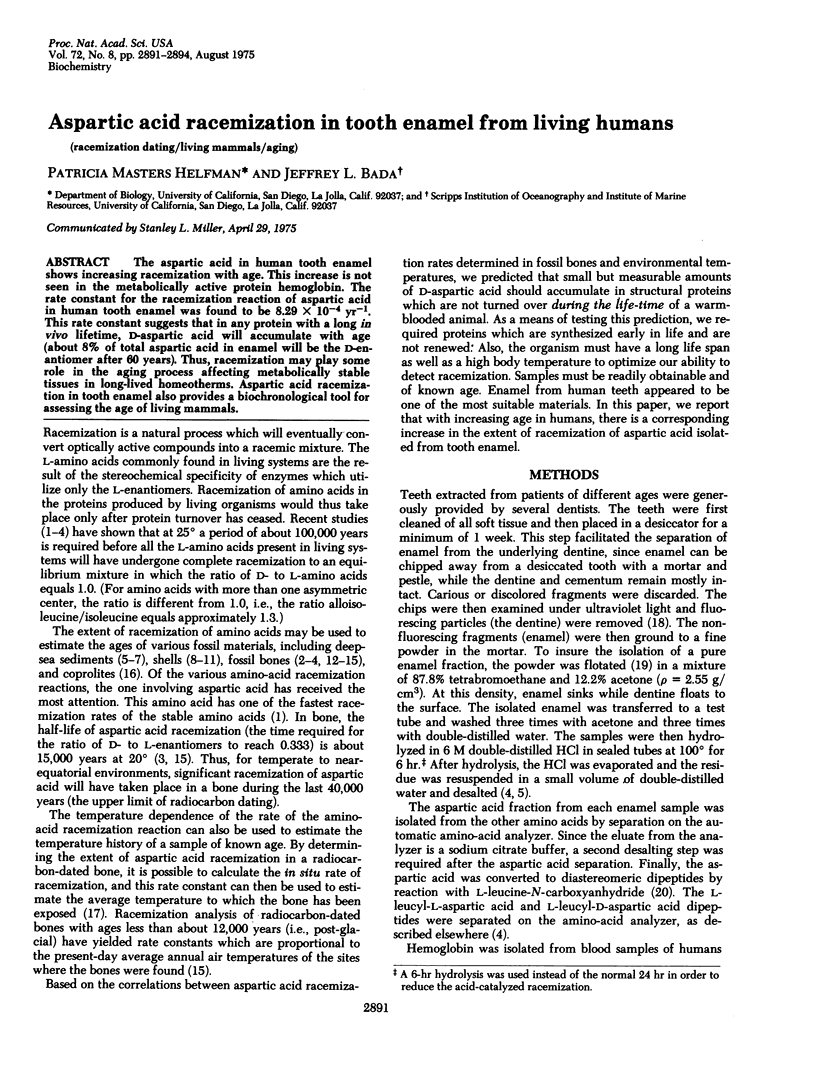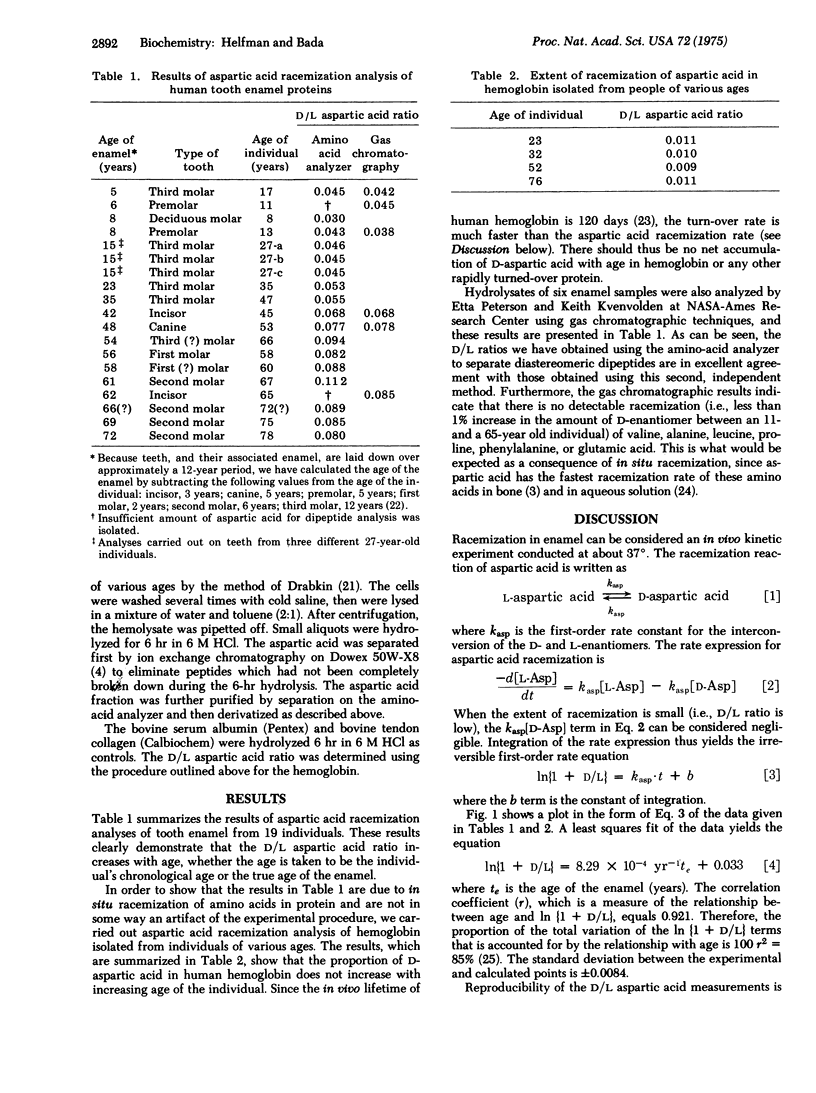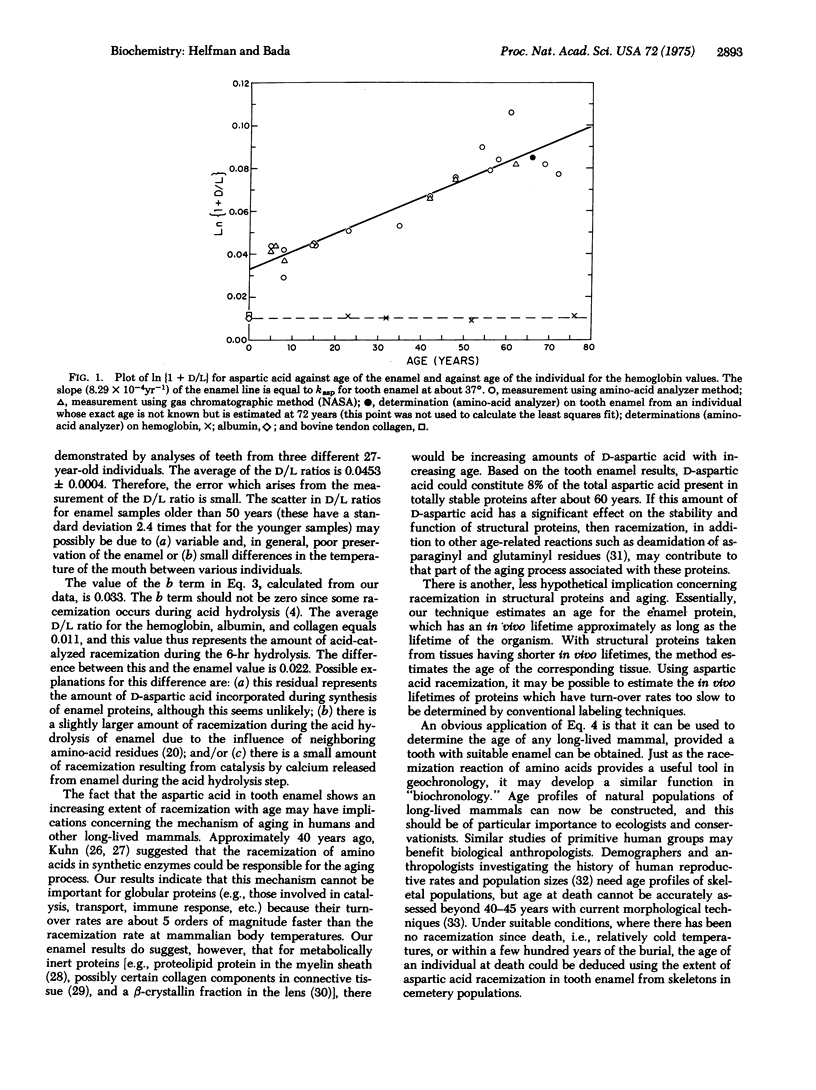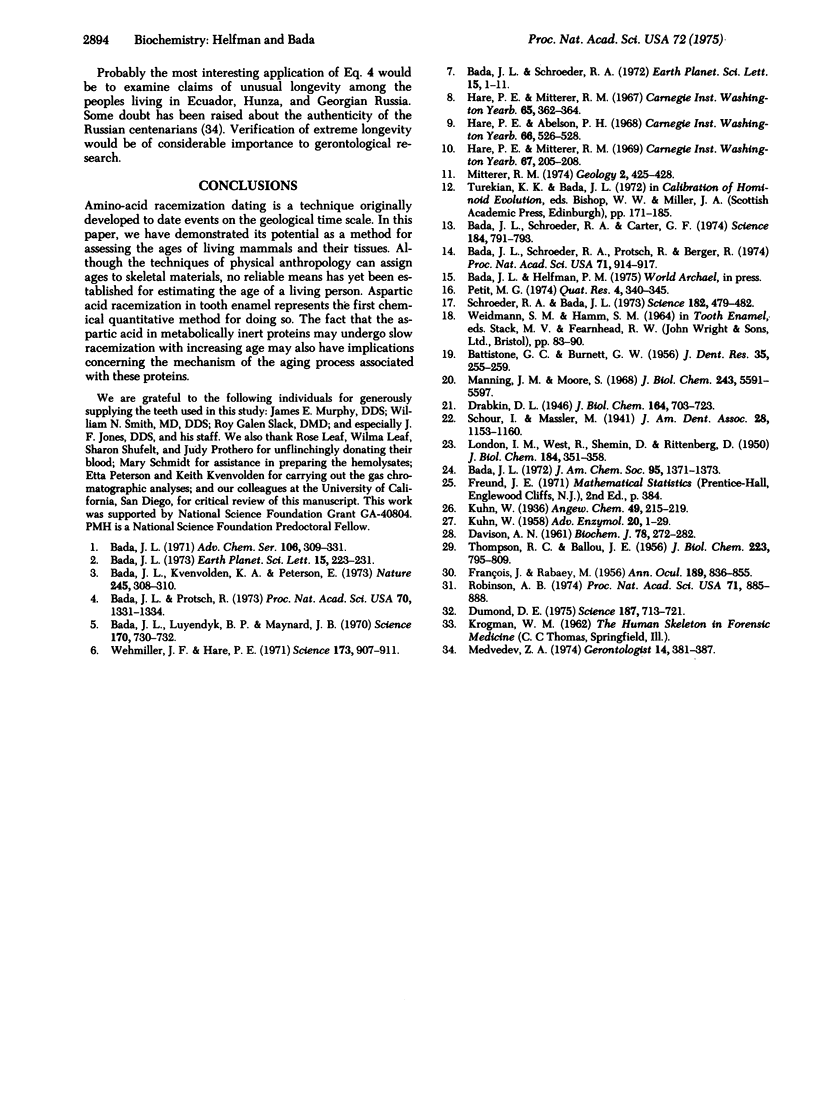Abstract
The aspartic acid in human tooth enamel shows increasing racemization with age. This increase is not seen in the metabolically active protein hemoglobin. The rate constant for the racemization reaction of aspartic acid in human tooth enamel was found to be 8.29 X 10(-4) yr-1. This rate constant suggests that in any protein with a long in vivo lifetime, D-aspartic acid will accumulate with age (about 8% of total aspartic acid in enamel will be the D-enantiomer after 60 years). Thus, racemization may play some role in the aging process affecting metabolically stable tissues in long-lived homeotherms. Aspartic acid racemization in toogh enamel also provides a biochronological tool for assessing the age of living mammals.
Full text
PDF



Selected References
These references are in PubMed. This may not be the complete list of references from this article.
- BALLOU J. E., THOMPSON R. C. Studies of metabolic turnover with tritium as a tracer. V. The predominantly non-dynamic state of body constituents in the rat. J Biol Chem. 1956 Dec;223(2):795–809. [PubMed] [Google Scholar]
- BATTISTONE G. C., BURNETT G. W. Studies of the composition of teeth. III. The amino acid composition of human dentinal protein. J Dent Res. 1956 Apr;35(2):255–259. doi: 10.1177/00220345560350021501. [DOI] [PubMed] [Google Scholar]
- Bada J. L. Kinetics of racemization of amino acids as a function of pH. J Am Chem Soc. 1972 Feb 23;94(4):1371–1373. doi: 10.1021/ja00759a064. [DOI] [PubMed] [Google Scholar]
- Bada J. L., Luyendyk B. P., Maynard J. B. Marine sediments: dating by the racemization of amino acids. Science. 1970 Nov 13;170(3959):730–732. doi: 10.1126/science.170.3959.730. [DOI] [PubMed] [Google Scholar]
- Bada J. L., Protsch R. Racemization reaction of aspartic Acid and its use in dating fossil bones. Proc Natl Acad Sci U S A. 1973 May;70(5):1331–1334. doi: 10.1073/pnas.70.5.1331. [DOI] [PMC free article] [PubMed] [Google Scholar]
- Bada J. L., Schroeder R. A., Carter G. F. New evidence for the antiquity of man in North America deduced from aspartic acid racemization. Science. 1974 May 17;184(4138):791–793. doi: 10.1126/science.184.4138.791. [DOI] [PubMed] [Google Scholar]
- Bada J. L., Schroeder R. A., Protsch R., Berger R. Concordance of collagen-based radiocarbon and aspartic-acid racemization ages. Proc Natl Acad Sci U S A. 1974 Mar;71(3):914–917. doi: 10.1073/pnas.71.3.914. [DOI] [PMC free article] [PubMed] [Google Scholar]
- DAVISON A. N. Metabolically inert proteins of the central and peripheral nervous system, muscle and tendon. Biochem J. 1961 Feb;78:272–282. doi: 10.1042/bj0780272. [DOI] [PMC free article] [PubMed] [Google Scholar]
- Dumond D. E. The limitation of human population: a natural history. Science. 1975 Feb 28;187(4178):713–721. doi: 10.1126/science.1090000. [DOI] [PubMed] [Google Scholar]
- FRANCOIS J., RABAEY M. De l'existence d'une protéine cristallinienne embryonnaire. Ann Ocul (Paris) 1956 Oct;189(10):836–855. [PubMed] [Google Scholar]
- KUHN W. Possible relation between optical activity and aging. Adv Enzymol Relat Subj Biochem. 1958;20:1–29. doi: 10.1002/9780470122655.ch1. [DOI] [PubMed] [Google Scholar]
- LONDON I. M., WEST R., SHEMIN D., RITTENBERG D. On the origin of bile pigment in normal man. J Biol Chem. 1950 May;184(1):351–358. [PubMed] [Google Scholar]
- Manning J. M., Moore S. Determination of D- and L-amino acids by ion exchange chromatography as L-D and L-L dipeptides. J Biol Chem. 1968 Nov 10;243(21):5591–5597. [PubMed] [Google Scholar]
- Medvedev Z. A. Caucasus and Altay longevity: a biological or social problem? Gerontologist. 1974 Oct;14(5 Pt 1):381–387. doi: 10.1093/geront/14.5_part_1.381. [DOI] [PubMed] [Google Scholar]
- Robinson A. B. Evolution and the distribution of glutaminyl and asparaginyl residues in proteins. Proc Natl Acad Sci U S A. 1974 Mar;71(3):885–888. doi: 10.1073/pnas.71.3.885. [DOI] [PMC free article] [PubMed] [Google Scholar]
- Schroeder R. A., Bada J. L. Glacial-postglacial temperature difference deduced from aspartic Acid racemization in fossil bones. Science. 1973 Nov 2;182(4111):479–482. doi: 10.1126/science.182.4111.479. [DOI] [PubMed] [Google Scholar]
- Wehmiller J., Hare P. E. Racemization of amino acids in marine sediments. Science. 1971 Sep 3;173(4000):907–911. doi: 10.1126/science.173.4000.907. [DOI] [PubMed] [Google Scholar]


